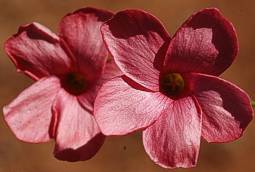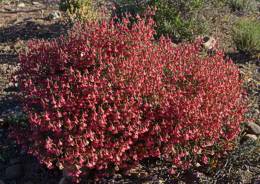Hermannia grandiflora
Hermannia grandiflora Aiton
Family: Malvaceae
Common names: desert rose (Eng.); klokkiebos, heuningbossie, ouma-se-kappie (Afr.)
Introduction
This striking species is as yet unknown in horticulture despite its alluring name, and is really worth growing as a pot plant, or in the garden or rock garden. When viewed from a distance, it gives the impression of being ablaze with a dazzling flush of bright reddish-pink flowers. Although the flowers do not last long, the desert rose will provide a spectacular spring/summer show and is ideally suited to water-wise gardens.

Description
Description
Hermannia grandiflora is a mounding/spreading, perennial shrub, up to about 1 m high. The stems and branches are stiff and twiggy, giving it a rather open, sparse habit. The leaves are oblong-cuneate, glabrous (non-hairy), toothed, olive green, and 5-15 mm long.

During particularly dry weather in summer, it sheds its leaves and goes into a state of dormancy until the next rains, after which the leaves soon re-appear. The flowers are a striking bright salmon-red to pink and pendulous (hanging), just like all other hermannias with the opening of the flower facing downwards. Each flower has five petals which overlap one another and flare at the opening to form the shape of a trumpet. There are two flowers per inflorescence which appear at every node on terminal branch tips and are resinous/sticky to the touch at the base. The flowers have a sweet fragrance. The fruits are small, cylindrical, oblong capsules without horns, ± 3-6 mm long, which dry to release tiny, hard brown seeds the size of coarse sand.

Hermannia grandiflora is closely allied to a number of other visually similar Hermannia species, namely: H. stricta, H. burchellii, H. fruticulosa and H. longipetala (manuscript name), all with a similar bushy habit and reddish pink flowers (see distribution map for clarification).
Conservation Status
Status
Currently there are no recognized threats to Hermannia grandiflora.
Distribution and habitat
Distribution description
Derivation of name and historical aspects
History
The specific name grandiflora literally means large-flowered, which refers to its relatively large-sized flowers compared to other members of the genus. It is one of about 200 species of Hermannia, most of which are from the dry tropics of Africa and with four species in the United States and one species in Australia. There are many other Hermannia species which make remarkable garden subjects.
It was first collected in the wild in 1791 by Sir Francis Masson and introduced into the living collections at Kew and then later described by W.T. Aiton of Kew in 1812.
Ecology
Ecology
It is suspected that Hermannia grandiflora is pollinated by bees primarily. It is a very palatable species and is thus heavily grazed when livestock have access to it!

Uses
Use
It is not known to have any cultural or medicinal uses.
Growing Hermannia grandiflora
Grow
This is a relatively easy plant to cultivate. It enjoys full sun and a hot spot in the garden or rockery and can also be grown as a pot plant, although it would have to be pruned to shape regularly. In the ground it tends to mound and spread and in a pot it will even cascade over the edge, and with its hanging flowers makes an excellent hanging basket subject as the flowers are best viewed from below. It grows in just about any soil you give it but prefers a well-drained potting medium.
Water the plant 2 to 3 times a week for the first three months after planting and then only once a week thereafter. It is a resilient survivor and may survive brief spells of severe drought but will take time to recover if at all. With time, it may survive without any watering at all (depending on the geographic area). It doesn't require much pruning but would benefit from a good pruning in early summer after it has finished flowering to re-invigorate it.
It doesn't require any feeding either but will benefit enormously from any type of fertilizer. Organic pelleted chicken manure works well.
It stays fairly pest-free and as such won't require any spraying. However, snails are an ever-present danger!
Propagation from semi-hardwood heel cuttings is easy. Use a powdered or liquid rooting hormone for faster rooting and bottom heat always speeds up the process too. These are best struck in autumn through to spring from new shoots. If seed is available, sow the seed at any time of the year in a shallow seed tray in a well-drained sandy medium. Cover the seeds with a very shallow layer of pure sand and water well with a damping-off fungicide. Keep moist in a warm place and germination should take place within 2 to 3 weeks.
Hermannia grandiflora is fairly slow-growing even under ideal conditions. In the wild, the plant probably could survive for up to 5-8 years and probably even longer in a cultivated garden with the proper care.
This is a rewarding species to grow, but sadly it is not commonly available in the horticultural trade yet. Kirstenbosch Botanical Gardens are growing it and are attempting to promote it to the public and nurseries through articles like this.
References
- Aiton, W.T. 1812. Hermannia grandiflora (Burch.) Ait. Hortus Kewensis, edn 2, 4: 141.
- Germishuizen, G. & Meyer, N.L. (eds). 2003. Plants of southern Africa : an annotated checklist. Strelitzia 14. National Botanical Institute, Pretoria.
- Verdoorn, I.C. 1986. Hermannia grandiflora. The Flowering Plants of Africa 49: t. 1922.
Credits
Adam Harrower
Kirstenbosch National Botanical Garden
October 2009
Plant Attributes:
Plant Type: Shrub
SA Distribution: Eastern Cape, Northern Cape, Western Cape
Soil type: Sandy, Clay, Loam
Flowering season: Spring, Early Summer, Late Summer
PH:
Flower colour: Red, Pink
Aspect: Full Sun
Gardening skill: Easy
Special Features:
Horticultural zones











Rate this article
Article well written and informative
Rate this plant
Is this an interesting plant?
Login to add your Comment
Back to topNot registered yet? Click here to register.